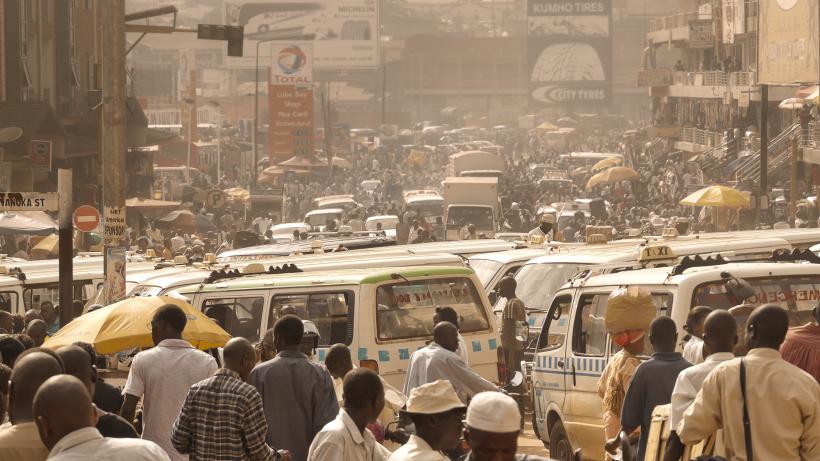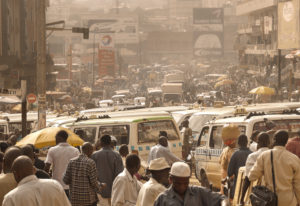
Kampala, where urbanisation is not synonymous with industrialisation
Many Sub-Saharan African cities have been growing at unprecedented rates. For example, according to the most recent census, in Kampala, the estimated resident night-time population currently lies at 1.5 million people. Some projections from the World Bank suggest that the city could expand to an estimated 9.1 million people by 2050. This figure does not include those people who travel to the city during the day to find jobs, which can lead to a doubling of the day time population.
Such rapid urbanisation is not unprecedented: European and Neo-European countries urbanised at these rates as part of their development and growth processes. However, a key difference is that in the latter set of countries, urbanisation was frequently accompanied by industrialisation, leading to cities becoming both the centres and the drivers for productivity for the rest of the economy.
Urbanisation does not mean industrialisation
Most of our historical and theoretical basis for urbanisation links city growth closely to industrialisation. This is not the case in cities like Kampala, where urbanisation has occurred with minimal expansion of the manufacturing sector. In fact the manufacturing sector still only contributes about 8% to overall GDP in Uganda. The divergence between these two processes is a major source of concern for policy makers, who are grappling with the challenge generating sufficient employment for city dwellers. According to recent World Bank estimates, the expected job deficit in Kampala will be 1 million by 2030. Furthermore, cities that have experienced urbanisation without industrialisation may struggle to provide the foundation for long-term growth in the surrounding rural economies. Therefore, it is important to analyse and understand why urbanisation is currently happening in this ‘non-traditional’ fashion to understand what policies can support urbanisation to dive productivity and ultimately support the overall economy attaining a higher growth trajectory.
Urbanisation without industrialisation
A recent paper entitled Urbanisation with and without Industrialisation (Gollin, Jedwab and Vollrath 2016) looks at industrialisation across 116 developing countries between the years 1960 and 2010. The paper asks what the drivers of urbanisation have been, and explores the differences between “production cities,” which are centres of manufacturing, or “consumption cities,” dominated by non-tradeable services.
Two of the main conclusions of the papers are:
- Urbanisation is always accompanied by higher income;
- The source of the growth in income is in fact what determines what type of urbanisation happens.
In particular, they note that in those countries where exports are dominated by natural resources, urbanisation will tend to take the form of consumption cities. In contrast, where higher incomes have resulted from developments outside the resource sector, then urbanisation is more likely to result in productivity increases in the tradeable sectors -- and thus to give rise to production cities.
This effect is largely due to labour market effects that shape the composition of employment in cities. In the case of natural resources -- including agriculture and mineral resources, such as oil -- production does not create many new jobs. In particular, mineral resources tend to be very capital intensive in their production. Yet so-called resource booms, particularly when commodity prices are high, can raise overall GDP and thus income per capita. In this case, therefore, when people move to cities and do not find sufficient employment opportunities in the manufacturing sector, they turn to retail and employment in other largely non-tradeable services. This is a key feature of consumption cities. The findings from the study also show that these types of cities are generally associated with higher poverty rates and a larger share of people living in slums. In short, the higher overall income does not translate into improved welfare or inclusive patterns of development.

Kampala as a consumption city
This trend holds true for Kampala as well. Uganda’s main exports are primarily in the commodity sector, namely coffee and maize. Following the liberalization of the coffee industry, as well as a number of other significant economic reforms in the 1990s, Uganda’s GDP has grown significantly, in some years reaching up to over 10% per year. This was one of the push factors raising overall income in the country and is also associated with rapid urbanisation, particularly in Kampala. However, as this income effect took hold, driving rural-urban migration and a shift of economic activity to the urban areas, the manufacturing sector stalled.
Instead, when people moved to Kampala, the majority set up their own businesses, primarily engaging in retail and service activities. This is evidenced by the fact that currently, according to the World Bank, approximately 53.7% of jobs are in the informal sector, with 55% of the enterprises employing only employing one person and 0.2% employing more than 50 people. Job creation has been through these micro enterprises, the majority of which operate in the non-tradeable sector and have struggled to exploit economies of scale. The, World Bank estimates that between 2001 and 2011, large-scale enterprises in the tradable sector have actually reduced the number of jobs.
Why urbanisation is still one of the single biggest growth opportunities for Uganda
The fact that urbanisation is not taking place in conjunction with industrialisation should not be discouraging to policy makers. Instead the focus should be how this form of urbanisation can provide new opportunities and from this determine an industrial base that can help support overall structural transformation.
One area for policy makers to consider is how to exploit the resource sector to support urban livelihoods. As urban diets are changing, and populations are moving towards consuming more processed foods, there is the potential of strengthening rural-urban linkages and having rural areas produce goods to support the cities. This should go beyond mere production of commodities but also look at branching out to agro-processing. The growth of supermarket chains in cities like Kampala shows that demand is on the rise; however, the local supply is lacking, and processed and prepared foods continued to be sourced from countries like Kenya and South Africa.
Between 2006 and 2013, urbanisation accounted for 1/10th of poverty reduction in Uganda, lifting approximately over 180,000 people over the poverty line. The potential for urbanisation to further support growth and poverty reduction is even larger. However, the patters of structural transformation may be different from those of European or Asian urbanisation.
As cities continue to grow rapidly in Uganda and other Sub-Saharan African countries, the opportunity and the necessity remains to get urbanisation right. This in turn will provide the foundation for achieving the productivity miracle within countries. Hence, urbanisation still holds one of the single strongest growth opportunities for countries like Uganda.

